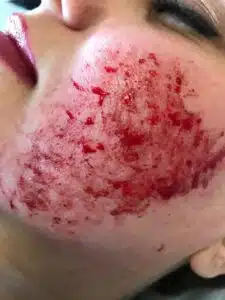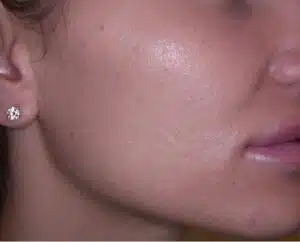Acne and acne scars are a common problem for many people, and can often have a significant impact on our self-confidence for months or years. While some people are lucky enough to have their acne disappear on its own, others need to seek professional treatment from a dermatologist or skin care specialist to improve their acne.
The Hautwerk team has many years of experience and a proven track record in the use of RF microneedling and other procedures to treat patients with moderate and severe skin conditions. Acne - and we can do the same for you.
Introduction
Whenever an acne outbreak occurs on our skin, the body reacts by initiating the healing process. During this process, the skin tries to repair itself by producing collagen, a protein that gives structure and support to the skin.
However, the healing process does not always go according to plan and Acne scars can easily form when severe or persistent inflammation is caused by acne lesions or when the healing process is interrupted, such as when a person squeezes their pimples or picks at their acne.
There are three main types of acne scars due to poor healing:
- Ice pick scars: These Scars are deep and very narrow, similar to a hole that an ice pick would make. They can reach deeper into the skin.
- Rolling Scars: These scars are wide and have rounded, uneven edges. They can cause the appearance of a wavy texture on the skin.
- Boxcar Scars: These scars are wide with steep, defined edges, similar to varicose scars.
- Hypertrophic scars: These scars occur when too much tissue is formed during the healing process. They are bulging and protrude above the surface of the surrounding skin. They are more common in severe forms of acne and are usually limited to the area of the original acne outbreak.

The good news is that any type of scar can be improved with professional treatment. One of the most effective treatments is radiofrequency (RF) microneedling, which we explain in detail in this guide. There are also other treatments such as laser therapy, chemical peels and fillers, which we discuss in more detail so you can compare the best treatment plans for your personal situation.
RF Microneedling Treatment
Microneedling is a non-surgical cosmetic procedure that uses tiny, sterile needles to create controlled micro-injuries on the surface of the skin. The needles stimulate the skin's natural healing process and trigger collagen and elastin production, two crucial components responsible for skin rejuvenation and repair. This is also known as collagen induction therapy or "dermarolling".
However, it is important to note that cosmetic microneedling procedures that penetrate only up to 0.5 mm are usually ineffective for acne scars and do not stimulate enough collagen production to produce significant improvement.
RF microneedling is a more advanced technique in which the needles penetrate the skin at the same time, Radio frequency energy which triggers a stronger natural healing response. With this method, we can target deeper layers of damaged skin to promote the formation of new collagen fibers, improve elasticity and initiate skin rejuvenation.
We believe this is the best method for treating acne scars in most cases, as it allows us to stimulate the skin to restructure on three levels. We use the gold standard RF microneedling devices that deliver RF energy deep below the skin's surface, allowing us to penetrate up to 3.5 mm. The treatment can also be performed in the summer and on darker skin types.


Frequently Asked Questions about RF Microneedling Treatment
How many sessions do I need?
The number of sessions needed depends on the type and severity of your scars, your individual skin characteristics, and the quality of the RF microneedling device used. For most patients, we generally recommend a treatment plan consisting of 3 to 6 sessions spaced about 4 to 6 weeks apart. However, results vary from person to person, so we can never guarantee exactly how many sessions you will need.
How long will the results last? Will my scars return?
The results of RF microneedling last a long time and many of our patients do not feel the need to undergo repeat treatments. However, this is not always the case and it is important to follow long-term aftercare instructions to achieve and maintain the best possible results.
Is there a disadvantage to RF microneedling?
We do not always recommend RF Microneedling for all individuals, especially those with certain skin conditions, active infections such as cold sores, or open wounds in the treatment area. Mild side effects such as redness and swelling are also common reactions that subside in the days or weeks following treatment.
Can RF Microneedling help with other skin conditions?
Yes, RF microneedling is a skin resurfacing technique that can be used to treat various other skin problems in addition to acne scars, such as Fine lines and wrinklesskin sagging, Stretch marks and sagging skinespecially on the face and neck. The combination of microneedling and RF energy stimulates collagen and elastin production, resulting in smoother, rejuvenated skin and a reduction in the signs of aging. Skin aging leads. It is also used in the treatment of certain surgical scars.
Other treatment options for acne scars
If radiofrequency microneedling is not a suitable treatment for you, there are several other options that can help you achieve the desired results and improvements in skin texture, acne pain, scarring and discoloration.
Injections
Acne scars can be treated with injections. Deep scars injected with hyaluronic acid to match the level of healthy skin. The area should then be re-injected approximately every 6 months. Thickened scar tissue is broken down by cortisone injections. For light scars, we recommend skin booster injections.
Laser
The CO2 laser (a fractionated ablative CO2 laser) is a recognized, low-complication and tissue-sparing laser with few risks. Numerous deep, but only 120 µm, i.e. 1/10 mm diameter, puncture holes are drilled into the skin, which activate the skin's self-healing powers.
Fruit acid peeling
The so-called Fruit acid peeling can also help with acne scars. This involves taking natural fruit acids in high concentrations, such as glycolic acid, to achieve a well-tolerated exfoliation of the skin. Peeling removes the top layer of dead skin cells to reveal fresh, intact skin tissue underneath. By peeling away the dead upper skin cells, the regeneration of the underlying skin cells is stimulated.
Book your RF microneedling acne treatment at Hautwerk
Improving the appearance of acne and acne scars requires expert knowledge and a carefully planned treatment strategy. You can be sure that at Hautwerk we have treated many patients in the same situation as you, so we can recommend the best approach to improve the appearance of your skin.
Contact us our friendly team today to arrange your consultation appointment!




